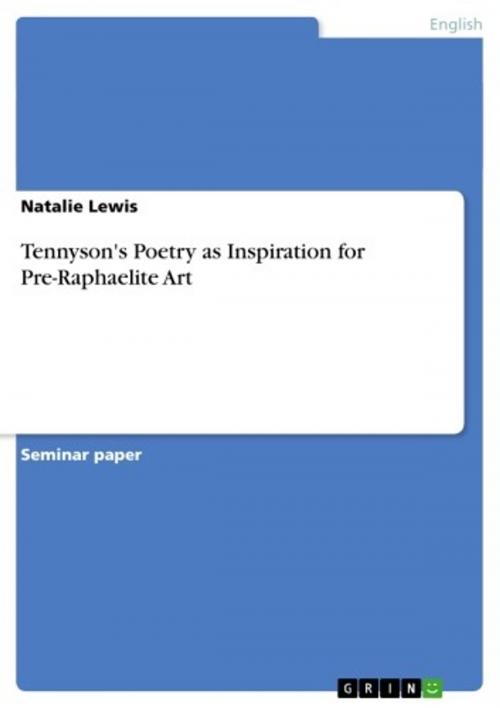Tennyson's Poetry as Inspiration for Pre-Raphaelite Art
Fiction & Literature, Literary Theory & Criticism, British| Author: | Natalie Lewis | ISBN: | 9783638291460 |
| Publisher: | GRIN Verlag | Publication: | July 14, 2004 |
| Imprint: | GRIN Verlag | Language: | English |
| Author: | Natalie Lewis |
| ISBN: | 9783638291460 |
| Publisher: | GRIN Verlag |
| Publication: | July 14, 2004 |
| Imprint: | GRIN Verlag |
| Language: | English |
Seminar paper from the year 2003 in the subject English Language and Literature Studies - Literature, grade: 1,0 (A), Free University of Berlin (Institute for English Philology), course: The Pre-Raphaelites in Art and Literature, 19 entries in the bibliography, language: English, abstract: In 1848, at the peak of British industrialism and urbanization, a group of artists founded the Pre-Raphaelite Brotherhood, a movement which revolted against contemporary academic art. Searching for new themes of a higher truth and purity, the group did not only turn to artistic and literary sources of the Medieval Ages, the Renaissance and Romanticism but also to the poetic work of the contemporary Victorian Alfred Lord Tennyson. The Pre-Raphaelite Brotherhood and the poet laureate shared a poetic affinity with medieval literature and culture. The Middle Ages provided an ideal counter world of romance, chivalry, simple order, and religious faith. In an era of modern science, Darwinism, and religious scepticism, Tennyson found his sources of inspiration in Arthurian legends and Shakespearian drama. Between the mid 19th century and the end of World War I, Pre-Raphaelite artists produced a great number of paintings and illustrations, ie. the illustrated Moxon Edition of Poems (1857), based on the work of Alfred Tennyson. Significant thematic fascination was directed towards early romantic maiden poems, i.e. 'Mariana' and 'The Lady of Shalott', both published in 1832 and revised in 1842. This research paper will examine the structure, atmosphere, and symbolism of these Tennysonian ballads and analyze the corresponding paintings of John Everett Millais, William Holman Hunt, and John William Waterhouse.
Seminar paper from the year 2003 in the subject English Language and Literature Studies - Literature, grade: 1,0 (A), Free University of Berlin (Institute for English Philology), course: The Pre-Raphaelites in Art and Literature, 19 entries in the bibliography, language: English, abstract: In 1848, at the peak of British industrialism and urbanization, a group of artists founded the Pre-Raphaelite Brotherhood, a movement which revolted against contemporary academic art. Searching for new themes of a higher truth and purity, the group did not only turn to artistic and literary sources of the Medieval Ages, the Renaissance and Romanticism but also to the poetic work of the contemporary Victorian Alfred Lord Tennyson. The Pre-Raphaelite Brotherhood and the poet laureate shared a poetic affinity with medieval literature and culture. The Middle Ages provided an ideal counter world of romance, chivalry, simple order, and religious faith. In an era of modern science, Darwinism, and religious scepticism, Tennyson found his sources of inspiration in Arthurian legends and Shakespearian drama. Between the mid 19th century and the end of World War I, Pre-Raphaelite artists produced a great number of paintings and illustrations, ie. the illustrated Moxon Edition of Poems (1857), based on the work of Alfred Tennyson. Significant thematic fascination was directed towards early romantic maiden poems, i.e. 'Mariana' and 'The Lady of Shalott', both published in 1832 and revised in 1842. This research paper will examine the structure, atmosphere, and symbolism of these Tennysonian ballads and analyze the corresponding paintings of John Everett Millais, William Holman Hunt, and John William Waterhouse.















